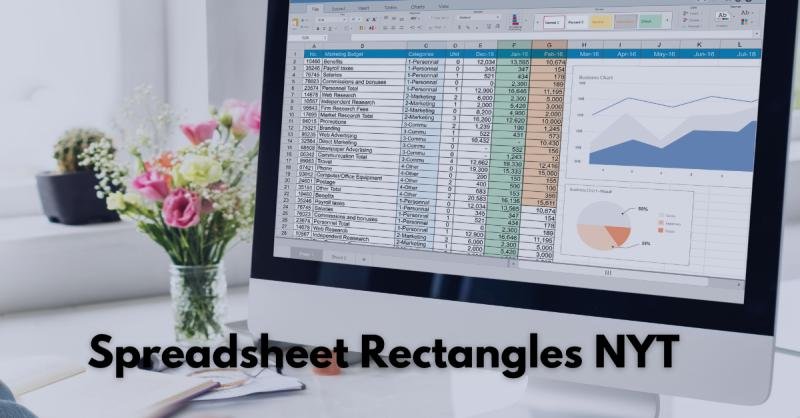Spreadsheet rectangles, often referred to as cells, form the backbone of every spreadsheet, including those used in the New York Times (NYT) or other analytical platforms. These seemingly simple units play a critical role in organizing, calculating, and presenting data in a structured manner.
In this article, we’ll dive into the concept of spreadsheet rectangles NYT, explore their applications, and explain why they are essential for modern data management.
What Are Spreadsheet Rectangles?
Spreadsheet rectangles are the grid components or cells within a spreadsheet, where data is entered and manipulated. Each rectangle is defined by its position, which is determined by a unique combination of a column letter and a row number (e.g., A1, B2).
Key Features:
- Data Storage: Each cell can hold text, numbers, or formulas.
- Grid Structure: Organized in columns and rows, creating a grid layout.
- Interactivity: Can be formatted, resized, or connected to other cells for calculations.
These rectangles in spreadsheets NYT are vital for creating organized and functional spreadsheets, especially in journalism, analytics, and data visualization.
The Role of Spreadsheet Rectangles in NYT
The New York Times (NYT) often uses spreadsheets for data-driven stories, analysis, and visualizations. These NYT spreadsheet cells play a crucial role in:
1. Data Analysis
Journalists use spreadsheet grid boxes NYT to analyze trends, calculate statistics, and organize large datasets for reporting purposes.
2. Storytelling with Data
Visualizations and charts derived from spreadsheet grid components NYT help tell compelling stories, making data more accessible to readers.
3. Collaborative Work
Teams at NYT rely on spreadsheets to collaborate efficiently, with each member contributing to specific spreadsheet column and row boxes NYT.
By leveraging the flexibility of these rectangular units in spreadsheets NYT, NYT ensures accuracy and clarity in its reporting.
Why Are Spreadsheet Rectangles Important?
The significance of spreadsheet rectangles or cells NYT extends beyond data entry. They provide a foundation for efficient data management and analysis.
Benefits:
- Organization: Keep data structured and easy to navigate.
- Scalability: Handle everything from small lists to massive datasets.
- Automation: Enable dynamic calculations using formulas and functions.
- Customization: Offer formatting options to highlight key information.
These features make NYT spreadsheet grid units indispensable for professionals and enthusiasts alike.
How to Use Spreadsheet Rectangles Effectively
To maximize the potential of spreadsheet grid boxes NYT, follow these practical tips:
1. Organize Data Properly
Use distinct columns for categories and rows for individual entries. This makes it easier to filter and sort data.
2. Utilize Formulas
Leverage built-in functions to perform calculations and automate repetitive tasks within spreadsheet cell blocks NYT.
3. Format Cells
Apply bold text, colors, or conditional formatting to emphasize critical information.
4. Link Cells for Calculations
Use cell references to connect grid rectangles in spreadsheet software NYT, enabling dynamic updates across the sheet.
These strategies ensure that your spreadsheet rectangles or cells NYT work efficiently to support your objectives.
Real-World Applications of Spreadsheet Rectangles NYT
1. Journalism and Reporting
The NYT uses spreadsheets for data journalism, where spreadsheet boxes NYT are crucial for organizing election results, COVID-19 data, and economic statistics.
2. Business Analysis
Companies use NYT grid rectangles in spreadsheets for budgeting, forecasting, and financial reporting.
3. Education and Research
Students and researchers rely on rectangular cells in spreadsheets NYT for managing project data and conducting experiments.
These applications showcase the versatility of spreadsheet rectangles in various domains.
Challenges and Solutions
While spreadsheet rectangles NYT are highly functional, they can pose challenges when managing large datasets.
Common Challenges:
- Data Overload: Handling too much data can make spreadsheets overwhelming.
- Errors in Formulas: Misplaced cell references can lead to inaccurate calculations.
- Formatting Issues: Poor formatting makes data hard to read.
Solutions:
- Use filters and pivot tables to simplify data analysis.
- Double-check formulas for accuracy.
- Apply consistent formatting across all spreadsheet column and row boxes NYT.
By addressing these challenges, you can optimize your use of spreadsheet rectangles or cells NYT.
FAQs About Spreadsheet Rectangles NYT
1. What are spreadsheet rectangles?
They are the grid components or cells in a spreadsheet, used to store and organize data.
2. How does NYT use spreadsheet rectangles?
The NYT uses them for data analysis, visual storytelling, and collaborative reporting.
3. Why are spreadsheet rectangles important?
They help organize data, perform calculations, and create visualizations for better decision-making.
4. Can spreadsheet rectangles handle large datasets?
Yes, but tools like filters, formulas, and pivot tables are essential for managing large datasets effectively.
5. How do I format spreadsheet rectangles for better readability?
Use bold text, color coding, and conditional formatting to highlight key data points.
Conclusion
The spreadsheet rectangles NYT are more than just cells in a grid—they are tools that empower users to organize, analyze, and present data effectively. Whether you’re a journalist at the NYT, a business analyst, or a student, these cells form the foundation of modern data management.
By understanding how to use NYT spreadsheet cells efficiently, you can unlock their full potential and transform raw data into actionable insights. With the right strategies and tools, these rectangular units in spreadsheets NYT will continue to drive innovation and clarity in every field they touch.
